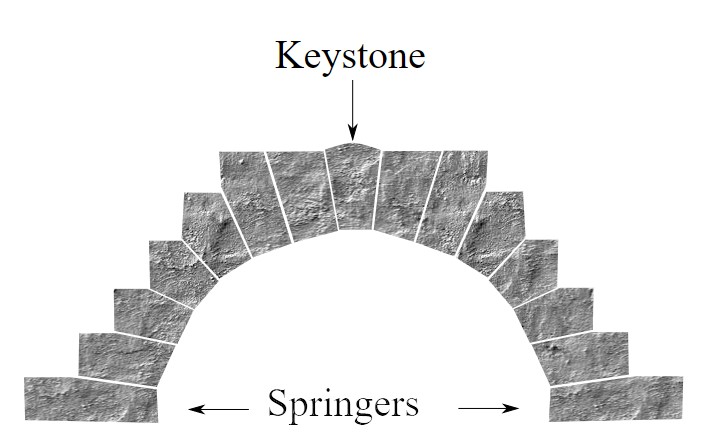Voussoir

|
| This image depicts the voussoir stones of an arch, including the keystone and the springers. |
Contents |
[edit] Introduction
The construction of traditional masonry arches and vaults is dependent on the arrangement of the bricks, blocks or stones over the opening. A tapered or wedge-shaped stone forming one of the units of the arch or vault is called a voussoir. Downward pressure on the structure has the effect of forcing the voussoirs together (in compression) instead of apart. Precision must be used when cutting voussoirs in order to ensure that this pressure is sufficient and uniform against the adjacent blocks.
Each unit in an arch or vault is a voussoir. The voussoir that is positioned in the centre of the arch is known as the keystone. The bottom voussoirs resting on the springing line are referred to as springers. The springing line is the point from which the arch starts to rise from its vertical supports.
[edit] Origins of the term
The term voussoir comes from the old French word vosoir, which has its origins in the Vulgar Latin word volvere (meaning to turn around or to roll). It is this reference, “to turn or roll”, that relates to the action of the wedge-shaped voussoir. Each voussoir rolls to the side to force it into place and create the supporting action needed to distribute weight.
[edit] History
Early voussoirs appeared in 16th century arches found in Italian Mannerist architecture. The technique created a stylistic departure from traditional Renaissance structures. They were also used with dramatic effect in other parts of the Mediterranean, sometimes created using red and white stones arranged in alternating patterns. This effect was also used in Romanesque architecture.
By the 18th and 19th century, bricks and mortar were used to create a new type of voussoir. British bricklayers found they could use standard bricks by thickening vertical mortar joints to produce an arch that was sufficiently supportive.
[edit] Related articles on Designing Buildings
Featured articles and news
The history of building regulations
A story of belated action in response to crisis.
Moisture, fire safety and emerging trends in living walls
How wet is your wall?
Current policy explained and newly published consultation by the UK and Welsh Governments.
British architecture 1919–39. Book review.
Conservation of listed prefabs in Moseley.
Energy industry calls for urgent reform.
Heritage staff wellbeing at work survey.
A five minute introduction.
50th Golden anniversary ECA Edmundson apprentice award
Showcasing the very best electrotechnical and engineering services for half a century.
Welsh government consults on HRBs and reg changes
Seeking feedback on a new regulatory regime and a broad range of issues.
CIOB Client Guide (2nd edition) March 2025
Free download covering statutory dutyholder roles under the Building Safety Act and much more.
AI and automation in 3D modelling and spatial design
Can almost half of design development tasks be automated?
Minister quizzed, as responsibility transfers to MHCLG and BSR publishes new building control guidance.
UK environmental regulations reform 2025
Amid wider new approaches to ensure regulators and regulation support growth.
The maintenance challenge of tenements.
BSRIA Statutory Compliance Inspection Checklist
BG80/2025 now significantly updated to include requirements related to important changes in legislation.






















